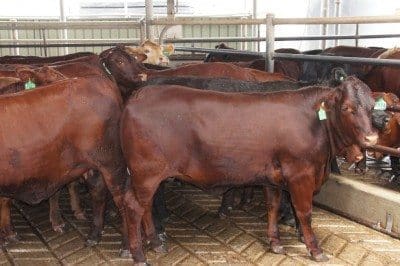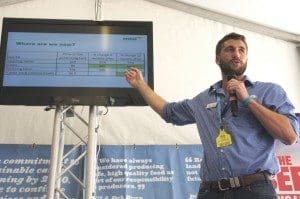PERHAPS not surprisingly, a sharp decline in female numbers has been a big contributor to dramatically lower weekly beef kills across Eastern Australia this year.
Within that, there’s evidence that the big drop in female slaughter is heavily skewed towards cull cows. Somewhat surprisingly, given the growing demand for breeder replacements, heifer slaughter does not appear to have declined as much as some might have anticipated.
The big slide in female kill this year is clearly evident in NLRS weekly kill reports. While slaughter numbers in general are substantially down on last year, it’s the female side of the equation that’s being worst affected.
The past three weeks have seen Queensland female kills accounting for only 36-39 percent of the state’s overall slaughter tallies. Compare that with this time last year, when the figure ranged from around 45-49pc, and of course, a much larger outright number of cattle being processed.
What’s interesting is that the current decline in female slaughter is heavily skewed towards cull cows, rather than heifers. Inquiries with the two largest domestic users of fed heifers suggest the heifer proportions of their overall kills are virtually unchanged from normal trends.
By far the biggest end-users of fed heifers are Woolworths and Coles. Both told Beef Central last week that their heifer slaughter numbers, as a percentage of overall kill, are down only very marginally or not at all.
Logic would have suggested more of those heifers would now be being held back as breeder replacements, especially in those areas that have had adequate rain.
In the US beef industry, where post drought herd recovery is now well underway, there were 7 percent fewer heifers in feedlots in January compared with the same time last year. Heifer numbers were 267,000 head lower at the start of 2016, indicating more replacement heifers are being retained.
In its northern supply chain, Coles says heifer numbers being slaughtered are back – “but only slightly” – perhaps a 5pc swing towards steers over heifers from what’s seen normally. In its southern supply chain, there’s been virtually no change, the company said. At times Coles can use 65-70pc heifers in its domestic grainfed requirements.
Similarly, Woolworths has told Beef Central it has seen little or no change so far this year in its proportion of heifers being fed and processed – typically 50-55pc of all its domestic grainfeds.
There’s little difference in price between fed domestic steers and heifers in the north at present. On feeder cattle, as evidenced in recent sales on AuctionsPlus, on a per kilo basis some lines of feeder/store heifers have been very close to or equal to equivalent steer prices. That’s been driven by restocker demand, together with some live export influence, market watchers told Beef Central.
Whether that trend persists, or advances further will ultimately depend on rainfall, further live export demand and other factors.
One theory put forward during discussions with stakeholders this week was that some producers might have been inclined to hold older cows and try to get an additional calf out of them, because of the relatively steep decline in cow prices this year, relative to the heifer market.
Lag factor in heifer trend?
A senior livestock manager with one of the nation’s largest beef processors noted the surprising strength in heifer numbers still on domestic feed programs, but pointed out that those heifers being slaughtered now, having had 60-70 days on feed, had been bought back in November-December.
“I think there’s a lag factor, but we will see fed heifer numbers start to change from now on,” he said.
“Lotfeeders are going to find the heifer portion a lot harder to find, at the right price.”
Despite the fact it was still very dry in large parts of Queensland and southern states, dry cow numbers delivered to the meatworks had already come to a “shuddering stop”, right across the eastern states, he said.
“You can still get 555c for a domestic grassfed heifer on a grid, which is not that much less than where it finished off last year. Heavy cows, on the other hand, have fallen from 525c/kg dressed weight late last year to 465c today – a 60c decline. That’s entirely due to the big reduction seen in US manufacturing meat prices, and poor demand generally for grinding meat and cow cuts.”
“But heifer prices could well go past equivalent steers this year as replacements,” he said. “It’s a lot cheaper to restock with a 350kg heifer than to buy cows and calves or PTIC cows at current prices.”
Female kill could fall to 42pc this year
Meat & Livestock Australia’s analyst Ben Thomas looked into the female kill trends, at Beef Central’s request.
Comparing the two past drought years of 2014 and 2015, while the overall Australian cattle slaughter was steady year-on-year at around nine million head, there were big differences by gender, he found.
“The male component was more or less unchanged over the past two years. But the female kill declined 5 percent year-on-year, and virtually all of that happened in the final five months of 2015, as female numbers were exhausted.”
“We’d expect that same declining female trend to continue through 2016, and perhaps intensify,” Mr Thomas said.
“It was basically 50:50 last year, but in 2016, that ratio could easily go to 55pc males, and 45pc or even as low as 42pc females. That sort of ratio is fairly typical in a big herd rebuilding year. ”
“The long-term average is 47pc females in the kill. Less than that, and the herd is in rebuilding phase. More than that, and it’s in decline.”
Mr Thomas said the reports out of Woolworths and Coles about slaughter heifer numbers was perhaps understandable, given how high numbers on feed remained. December quarter cattle on feed figures released late last week showed a record number, just short of a million head.
Asked to speculate about the capacity for lotfeeders to continue to pay for heifers this year, should restocker demand continue to grow, he used some figures from Roma store sales as an indicator.
“It looks like the assumption of a lag factor in heifer numbers being killed this week reflecting feeder purchases made late last year could be correct,” he said.
“The price paid by feeders for yearling heifers sold through Roma late last year (October-December) was in fact higher than what restockers were paying. It’s only in the past month that restockers have been paying a premium over feedlot operators, for the same lines of heifer cattle. Exactly the same applies on yearling steers,” Mr Thomas said.
“So the tie may have turned.”
Mr Thomas also dug out some data to try to answer the question, “Do heifers go past equivalent steers in value sometime this year?”
Traditionally, during previous similar cattle cycles coming out of prolonged dry periods, that did not happen, he said.
“What we’re seeing at the moment is the occasional line where similar description heifers are outpricing steers. But in the great majority, steers remain at a premium – typically still 20-30c at centres like Roma.”
“There’s always going to be those few heifer lines that make a premium, but every other time we have come out of a drought, steers have continued to outsell heifers – even though there is fewer of them around, and the obvious likelihood of restocking and herd rebuilding demand.”
“It hasn’t happened in the past, so I would be surprised if it happens consistently this year, given some decent rain.”
“Even though every drought the industry comes out of is exactly the same in that there are a lot of producers wanting to retain female stock or buy females to rebuild their herds, without exception in the past, steers have continued to command a higher c/kg price, on average, and I’d expect that to be the case going forward this year.”
“The gender difference certainly can narrow in such times, but there’s been no evidence of heifers ever commanding a premium, with any consistency.”
Dairy cull may be propping up female kills in NSW
While Queensland’s female kill is substantially lower as a percentage than it was this time last year, reductions in NSW are nowhere near as large. Last week (w/e 19/2) and the week before, the NSW female kill was still 48pc of the total.
“That resilience could be partly due to the larger dairy slaughter in NSW,” Mr Thomas told Beef Central.
“Milk powder prices are soft at the moment, and in dairy producing areas of both Australia and NZ, farmers are cashing in on high meatworks cow prices while milk prices are low.”
Queensland and NSW are the only two states that currently report weekly kills along gender lines, but upcoming ABS data identifying female kill in Victoria may shed more light on that ‘dairy factor’.
While female kill remains relatively high in NSW on percentage terms, the overall decline in the state’s slaughter numbers, down around 20 percent on peaks seen last year, means cow slaughter is still in decline.
“But the contribution of dairy cows is often overlooked when considering Australian beef production trends,” Mr Thomas said.
“The national dairy herd is about 1.8 million head. Working on a turnoff rate of about one-third each year would suggest there are about 600,000 dairy cows headed to slaughter each year in Australia.
“It’s not insignificant. Those dairy cows eventually become beef, and it’s important to take them into account when looking at herd size and beef production trends.”





HAVE YOUR SAY